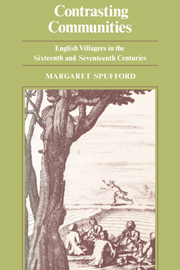Book contents
- Frontmatter
- Contents
- List of maps and graphs
- List of tables
- List of abbreviations
- Acknowledgements
- Dedication
- Introduction
- Map 1 Cambridgeshire: natural boundaries and soil types
- Map 2 Cambridgeshire: county and parish boundaries
- PART 1 People, Families and Land
- PART 2 The Schooling of the Peasantry
- PART 3 Parishioners and their Religion
- 9 Dissent before and after the commonwealth
- 10 A general view of the laity in the diocese of Ely
- 11 Fragmentation and the growth of sects
- 12 The possible determinants of dissent
- 13 The reality of religion for the villager
- Conclusion
- Appendix 1 The Butlers of Orwell
- Appendix 2 Notes on Graphs 3 and 5
- Index of Contemporary Names
- General Index
10 - A general view of the laity in the diocese of Ely
Published online by Cambridge University Press: 25 January 2010
- Frontmatter
- Contents
- List of maps and graphs
- List of tables
- List of abbreviations
- Acknowledgements
- Dedication
- Introduction
- Map 1 Cambridgeshire: natural boundaries and soil types
- Map 2 Cambridgeshire: county and parish boundaries
- PART 1 People, Families and Land
- PART 2 The Schooling of the Peasantry
- PART 3 Parishioners and their Religion
- 9 Dissent before and after the commonwealth
- 10 A general view of the laity in the diocese of Ely
- 11 Fragmentation and the growth of sects
- 12 The possible determinants of dissent
- 13 The reality of religion for the villager
- Conclusion
- Appendix 1 The Butlers of Orwell
- Appendix 2 Notes on Graphs 3 and 5
- Index of Contemporary Names
- General Index
Summary
Liturgical change in the reformation
Recent years of liturgical change have brought home to both Anglicans and Catholics the degree of disturbance which is caused among the laity by the alteration of words, actions, and the position of church furniture, all of which have a symbolic part to play in the administration of sacraments. Very often this disturbance cannot adequately be expressed in any logical way; the reason is a very adequate one. If the function of a symbol is to ‘represent the inexpressible in an unsurpassable way’, then, as a Catholic has written, ‘the Mass renders God present to us in an insurpassable way; in other words it is the symbol which communicates God to us’. If the Mass, the Eucharist, or the Lord's Supper is that which in one fashion or another communicates the relationship of God to man, then interference even with the details of the forms of expression of this relationship is bound to cause concern amongst the faithful, which often they themselves cannot account for. A change in the position of the altar or holy table from the east end, where the celebrant stands in front of his people and mediates the Christian sacrifice, to the midst of the people in the nave, means much more than the mere rearrangement of a room. It symbolises a difference in the way the relationship between people and God is demonstrated. A change in accustomed language, even if it is archaic or foreign, is disturbing in the same way.
- Type
- Chapter
- Information
- Contrasting CommunitiesEnglish Villages in the Sixteenth and Seventeenth Centuries, pp. 239 - 271Publisher: Cambridge University PressPrint publication year: 1974
- 1
- Cited by



